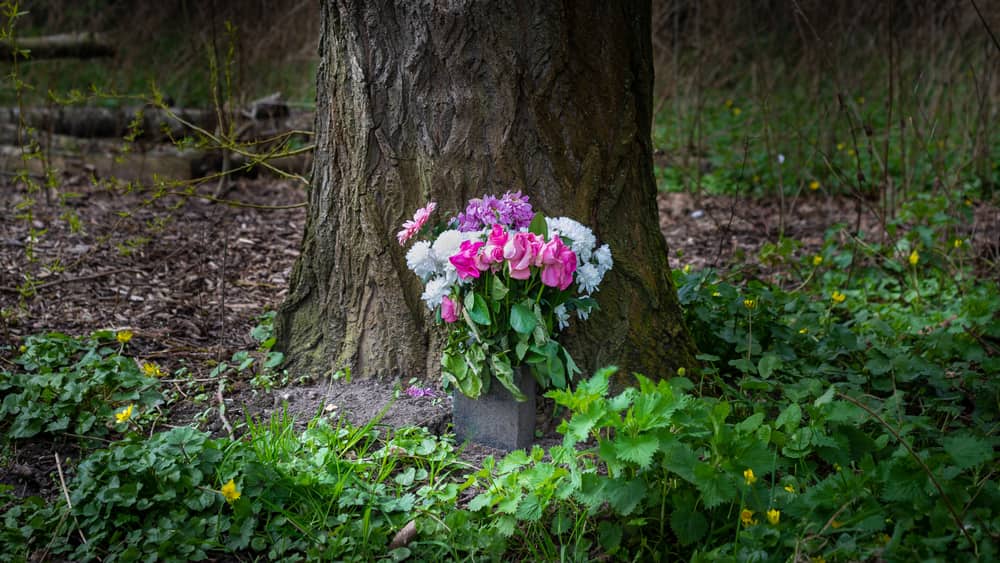
Meaning of Trees: Common Memorial Trees and Their Symbolism
You can make your Living Urn memorial even more meaningful by learning about the meaning of trees and choosing one that represents your loved one who has passed or your special relationship. This article will explore the symbolism and meaning behind six popular trees that would make lovely memorial trees.
Japanese Red Maple
This stunning tree holds great national significance to the people of Japan. Many mountains in Japan are covered with Japanese Red Maple trees, and each year in the fall, the whole country eagerly anticipates the spectacular, natural show of color as the leaves turn vibrant shades of red, orange, and yellow. The beautiful Japanese red maple is thought to represent elegance, beauty, and grace, making these trees a perfect memorial for your beautiful departed loved one. When it comes to care, the Japanese Red Maple:
-
Is easy to trim to your desired height.
-
Works well in small yards.
-
Grows 25’ tall and 20’ wide at maturity.
-
Needs full sun.
- Likes moist, slightly acidic, well-drained soil.
Weeping Willow
As you can imagine from a tree with “weeping” in the title, the Weeping Willow represents grief, loss, and mourning in many Asian cultures, especially in China, where these trees populate graveyards. The tree gains its name from its teardrop-shaped leaves that drip down its flexible branches. This tree is also culturally associated with grief in Western countries. However, there is the added symbolism of immortality and life after death, which can be found in the love people hold for one who has passed. The Weeping Willow:
-
Loves full sunlight.
-
Likes moist, well-drained soil close to a water source.
-
Can tolerate partial sun.
- Needs weekly watering during its first year.
Cherry Tree
Cherry trees are prized worldwide for their stunningly beautiful, fragrant blossoms. In Japan, they hold deep cultural significance and have for centuries. Cherry blossoms represent the cyclical nature of life and the impermanence of being. Cherry blossoms bloom, shocking in their loveliness, and fade into a frail shadow of what they once were soon after. This symbolism led ancient samurai warriors to use cherry blossom imagery. The Cherry tree:
- Blooms in the spring.
- Has attractive branches.
- May be deer resistant.
- Loves full to partial sun.
- Enjoys moist, well-drained soil.
Lilac
The Lilac tree or shrub is a stunning plant that produces heavenly scented flowers. It can also be grown as a shrub, which is more common for collecting its gorgeous blossoms. Native to Europe and imported to the U.S. by colonists, the lilac tree and its flowers hold a great deal of symbolism. In Greek mythology, a nymph named Syringa turned herself into lilac flowers to escape the god, Pan. Lilac trees have also been connected to the Easter holiday and its symbols of death and rebirth. The Victorians considered lilacs to be reminders of true love. Much of this symbology makes the Lilac tree an appropriate choice for a memorial tree. The Lilac tree:
-
Loves full sun and can tolerate partial shade.
-
Has beautifully scented flowers of various colors, depending on the variety.
- Likes moist, well-drained soil.
- Needs to be watered weekly in dry weather.
Southern Magnolia
Magnolia trees are as rich in symbolism as they are in decadent white blooms. Locally, here in the U.S., they symbolize luck and financial stability. Mississippi and Louisiana both use the Magnolia blossom as their state flower. However, Magnolias grow across the world, and in Chinese culture, these flowering trees stand for purity and nobility. This hardy tree has also come to represent endurance, strength, and everlasting bonds.
A variety of Magnolia that grows well here in the States is the Southern Magnolia. This famous tree grows huge, white blossoms from May to June. These blossoms are fragrant and complement the rich green foliage of the Southern Magnolia. In addition to its gorgeous flowers, the Southern Magnolia also produces a cone-shaped fruit beloved by wildlife. This is an easy-to-grow tree that requires little maintenance. The Southern Magnolia tree is:
- Flood resistant.
- Low maintenance.
- Drought resistant.
- Adaptable to most soil types.
- Watered 1-2x weekly the first year after planting.
Beech Tree
Grief and loss deserve to be acknowledged. It can be healing to erect symbols of our loss and how deeply it has affected us. The Beech tree may be an excellent choice for your loved one’s living urn since it symbolizes the act of walking across a threshold. These trees represent death or the end of something. Beech also stands for what comes next, as we walk through the challenges raised by the threshold and rise stronger and better after crossing. This could symbolize your loved one’s transition or your own as you pass through the threshold of grief and loss and rise again, stronger than before.
The American Beech tree is a stunning shade tree with a beautiful, broad canopy and leaves that turn a riot of fall colors. Wildlife loves the American Beech tree, but pests and insects rarely make a dent. The Beech tree produces a small, edible nut that is beloved by creatures great and small. The American Beech:
- Loves full sun but can tolerate partial shade.
- Needs moist, well-drained soil.
- Requires watering in the dry season.
- Grows to 50’-70’ tall and 40’ wide.
- Rate of growth: 6-9 inches a year.


